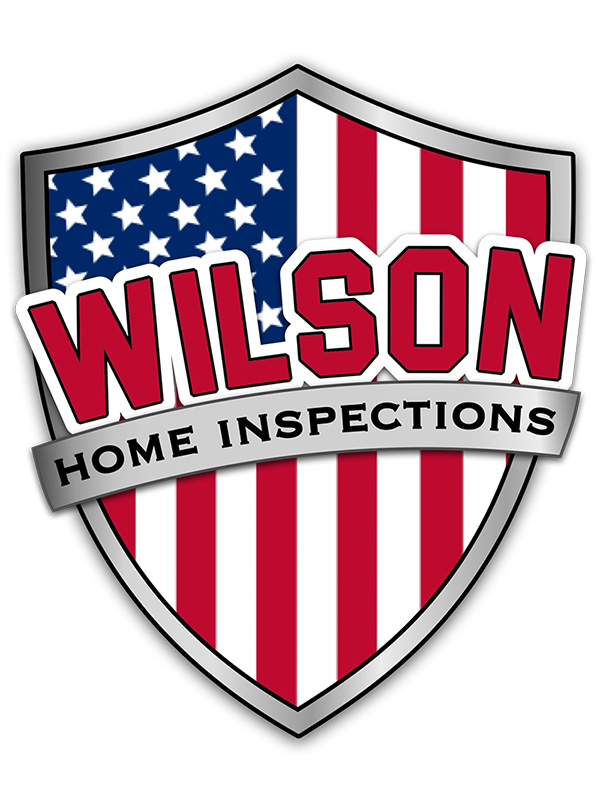When inspecting older homes, I frequently come across building materials that are suspected to contain asbestos fibers. (Only proper testing by a qualified laboratory can determine if asbestos is actually present.) As such, I strive to provide my clients with the most up to date information on asbestos and its associated hazards to enable them to make educated buying decisions. This weeks post from our friend Daniel King at Asbestos.com, “Guide To Asbestos In The Home”, aims to do just that. Daniel is an investigative writer who focuses on environmental issues such as the dangers of asbestos exposure. I hope you find this information as helpful as I did. Enjoy!
Guide to Asbestos in the Home
Homes built before the 1980s could expose homeowners, their families and others to asbestos possibly hiding in cement, floor tiles, insulation, walls and pipes. Our Guide to Asbestos in the Home can help protect you and others from exposure.
In the era of do-it-yourself home renovations, many homeowners are knocking down ceilings and walls, and tearing out floor tiles and old pipes. But in their efforts to upgrade and beautify their older homes, they might unknowingly be contaminating the air they breathe with toxic asbestos fibers. Our Guide to Asbestos in the Home offers information about asbestos, its dangers, what to do if you suspect it’s in your home, the dos and don’ts when handling asbestos and other useful information to keep you, your family and others safe in your home.
Is Asbestos in Your House Dangerous?
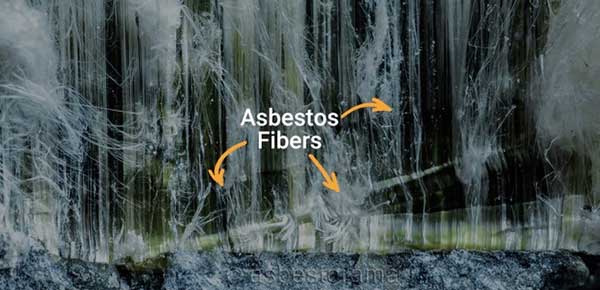
Asbestos is a natural mineral composed of thin fibers. When residential construction products made with asbestos are damaged, those fibers become airborne and could pose a danger to anyone who inhales the toxic dust. After years of exposure to those fibers, people may develop a cancer known as mesothelioma, which forms tumors on the lining of the lungs, abdomen or heart.
Where Can Asbestos Be Found in Your House?
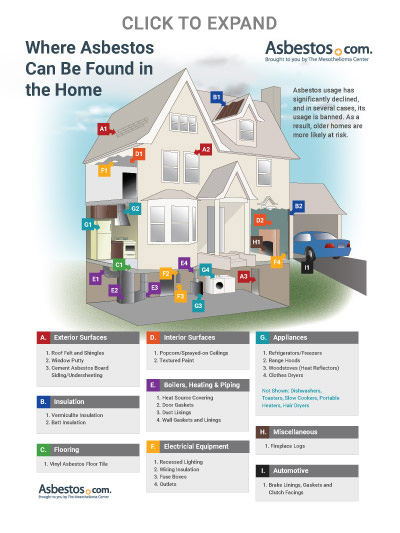
Many U.S. homes and public structures, such as schools, government housing and office buildings built before the 1980s, contain asbestos in:
- Cement
- Roof Shingles
- Steam Pipes
- Ceiling and Floor Tiles
- Textured Paint
- Spray-on Insulation
While many residential uses for asbestos were phased out, it remains legal in the U.S. for more than a dozen applications.
Common Exposure Scenarios
Asbestos exposure in your home can occur in different ways: DIY renovation, drilling through drywall or replacing an old pipe. The following scenarios describe how homeowners can expose themselves to asbestos at home.
Attic Renovation
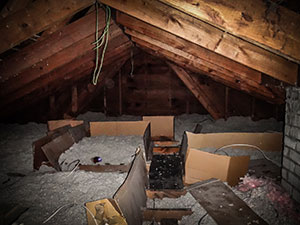
While remodeling the attic of his 1960s home, John found piles of brown pebble-like insulation. He decided to replace the existing insulation with new fiberglass insulation to save money in the winter months. He scooped the loose insulation into some garbage bags and installed the new material. John had no idea that his attic was insulated with asbestos-containing vermiculite. By disturbing the material, he spread asbestos fibers in the air. John should have left the insulation alone and had it tested for asbestos before disturbing it.
Brake Dust in Home Garage

Ralph loves working on his 1965 Corvette Stingray. When his brakes started to squeal, Ralph wanted to replace them in his own garage. After removing the rear tires, he saw the brake drums were covered in dust. He banged the sides with a hammer and blew off the dust with an air compressor. Because some brake components contain asbestos, spraying them with compressed air can release toxic fibers into the air. Ralph should have taken his car to the shop for service or wiped down the brake drums gently with a wet cloth.
Drilling in Drywall
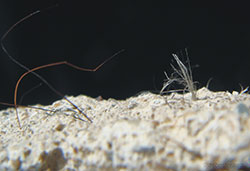
Erica recently won a painting at a silent auction and couldn’t wait to bring it home and hang it in her living room. She measured carefully and used a drill to install drywall anchors to keep the painting in place. The painting wasn’t level, so she had to drill a few more holes before it hung perfectly. She had no idea her home was built with asbestos-containing drywall. When she drilled through the wall to hang her painting, asbestos fibers from the drywall escaped into her living room. Erica should have known about the asbestos in her walls and left it alone.
Removing Vinyl Floor Tiles
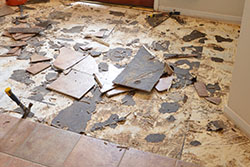
Herman just purchased a 1950s fixer-upper in his home town, and his first project was upgrading the master bathroom. He decided to start by removing the vinyl floor tile. He removed the existing tiles with a scraper and installed the new tile. Asbestos was a common ingredient in vinyl floor tiles in the 1950s. Using a scraper to remove the old flooring can release dangerous asbestos fibers. Herman should have installed the new tile over it.
Popcorn Ceiling Removal
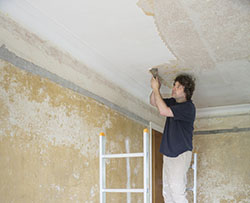
Janine was tired of the popcorn texture on the ceilings in her home, so she decided to scrape it off and repaint with a smooth finish. After putting on eye protection and a dust mask, she grabbed her ladder and got to work. After lots of scraping, a little sanding and some careful painting, she was finally done. Many textured ceiling finishes, including popcorn ceilings, have concealed asbestos. Scraping off the popcorn finish released microscopic asbestos fibers that easily passed through Janine’s dust mask. She should have hired a professional trained in safely removing asbestos hazards.
Cutting Insulation on Pipes
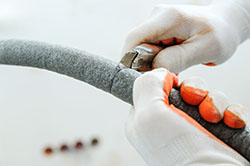
When fixing up the basement of his late-1800s Victorian home, Brent noticed the insulation around some of the hot water pipes was starting to deteriorate. Not wanting to lose any heat efficiency, he cut the old insulation with a utility knife and replaced it with new fiberglass insulation. Brent should have known that many older plumbing systems are wrapped in asbestos insulation. The insulation may have already posed an exposure risk before he started the project, but cutting the damaged material released even more fibers into the air. Brent should have hired an asbestos professional to seal the asbestos insulation.
What Can I Do About Asbestos in My Home?
If you find something in your home that you suspect is asbestos, don’t touch it. Even if the material is in good condition, the best option is to leave it alone. If the material appears damaged or future activities could disturb it, contact a trained and accredited asbestos professional. Limit access to the area until a professional can confirm the presence of asbestos. The best way to avoid asbestos exposure is to be knowledgeable about the asbestos materials in your home, including their locations and current condition.
How Can I Tell if a Material in My House Is Asbestos?
It’s extremely difficult to identify asbestos just by looking at it, so you need to send samples to a lab for testing. Homeowners can collect samples and have them tested, but it’s much safer for you and your family to hire a trained asbestos professional for the job. Search for “asbestos inspection” online to find a licensed expert in your area. The U.S. Department of Commerce offers a list of accredited asbestos laboratories online.
Asbestos Safety Dos and Don’ts
If you own an older home, take every precaution to avoid damaging materials that may contain asbestos. Even if a repair seems minor, you should hire a professional when asbestos may be present. Improper handling of safely managed asbestos can create an exposure risk where there was none before.
Dos
- Avoid any contact with dangerous asbestos materials.
- Take every precaution not to damage any materials that may contain asbestos.
- Talk to your home inspector or real estate agent about any known asbestos risks in your home.
- Only hire trained professionals for asbestos inspections, testing, repairs or removal.
- If you are planning on a demolition, contact the appropriate regulatory agency in your local or state government.
Don’ts
- Don’t saw, sand, scrape, drill or disturb materials that may contain asbestos.
- Don’t sweep, vacuum or dust debris that may contain asbestos.
- Don’t collect asbestos samples for testing without proper training.
- Don’t perform any work on or near asbestos materials unless you’re trained and certified.
- Don’t remove asbestos unless repair or concealment is impossible, and there’s a high risk for exposure.
- Don’t dispose of asbestos materials with normal household waste.
How Do I Get Tested for Possible Exposure to Asbestos?
If you are concerned about a possible exposure to asbestos, start by talking to your primary care physician. While no test can detect asbestos fibers in your lungs, your doctor can order imaging scans that reveal signs of asbestos-related disease. Asbestos-related conditions are difficult to detect, and not all primary care doctors have the tools and experience to diagnose them. If you know for certain that you were exposed to asbestos, and a test comes back negative, it is a good idea to seek a second opinion from a qualified lung specialist such as an occupational pulmonologist. Even if further tests come back negative, monitor your symptoms and get re-tested annually. Most asbestos-related diseases are diagnosed at least 15 years after exposure.
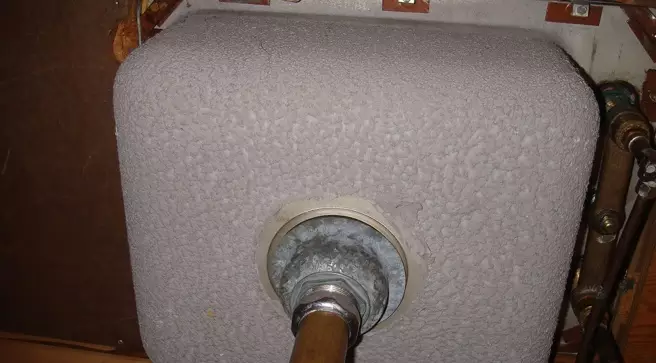
How Much Does Asbestos Testing Cost?
The cost of asbestos testing varies depending on the number of samples tested and the methods used. The most popular testing method, Polarized Light Microscopy (PLM), can range from $20 to $100 per sample. Some labs use Transmission Electron Microscopy (TEM), which is more expensive. DIY test kits require you to mail samples to an accredited lab, which may charge an additional fee that is typically around $40 for analysis. However, if you collect samples, you can create exposure risks. It’s best to hire a certified professional. The total cost of labor can run between $350 and $600 — a small price to pay for peace of mind that the job will be safely completed.
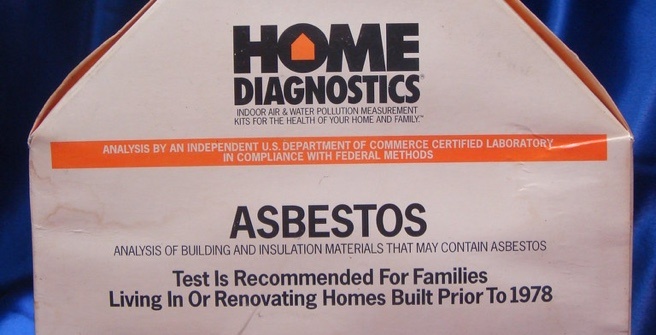
What Happens if I Violate Asbestos Laws?
Any activity involving asbestos must follow U.S. Environmental Protection Agency regulations as well as any state asbestos laws. Some asbestos violations result in written warnings. Others can bring criminal charges, prison time or daily civil penalties as high as $25,000 for each violation, depending on the severity of the infraction.
Harmed by Secondhand Exposure?
Free Mesothelioma Guide
Qualify for Free Medical Care

Daniel King
Daniel King joined Asbestos.com in 2017. He comes from a military family and attended high school on an Air Force base in Japan, so he feels a close connection to veterans, military families and the many hardships they face. As an investigative writer with interests in mesothelioma research and environmental issues, he seeks to educate others about the dangers of asbestos exposure to protect them from the deadly carcinogen. Daniel holds several certificates in health writing from the Centers for Disease Control and Prevention, and he is a member of the National Association of Science Writers.
7 Cited Article Sources
The sources on all content featured in The Mesothelioma Center at Asbestos.com include medical and scientific studies, peer-reviewed studies and other research documents from reputable organizations.
- Florida Department of Environmental Protection. Asbestos FAQ. (2019, January 25). Retrieved from: https://floridadep.gov/air/permitting-compliance/content/asbestos-faq
- U.S. Environmental Protection Agency. (2018, August 9). U.S. Federal Bans on Asbestos. Retrieved from: http://www2.epa.gov/asbestos/us-federal-bans-asbestos
- U.S. Environmental Protection Agency. (2018, September 17). Protect Your Family. Retrieved from: http://www2.epa.gov/asbestos/protect-your-family#professionals
- National Cancer Institute. (2017, June 7). Asbestos Exposure and Cancer Risk. Retrieved from: https://www.cancer.gov/about-cancer/causes-prevention/risk/substances/asbestos/asbestos-fact-sheet
- Agency for Toxic Substances and Disease Registry. (n.d.). Asbestos and Health: Frequently Asked Questions. Retrieved from: https://www.atsdr.cdc.gov/phs/phs.asp?id=28&tid=4
- U.S. Consumer Product Safety Commission. (n.d.). Asbestos in the Home. Retrieved from: https://www.cpsc.gov/safety-education/safety-guides/home/asbestos-home
- U.S. Environmental Protection Agency. (n.d.). Asbestos Frequently Asked Questions. Retrieved from: http://www2.epa.gov/sites/production/files/documents/asbestosfaqs_0.pdf
